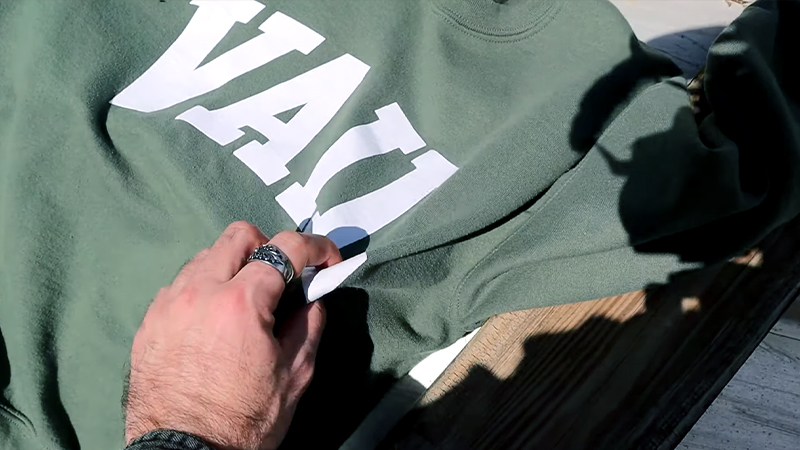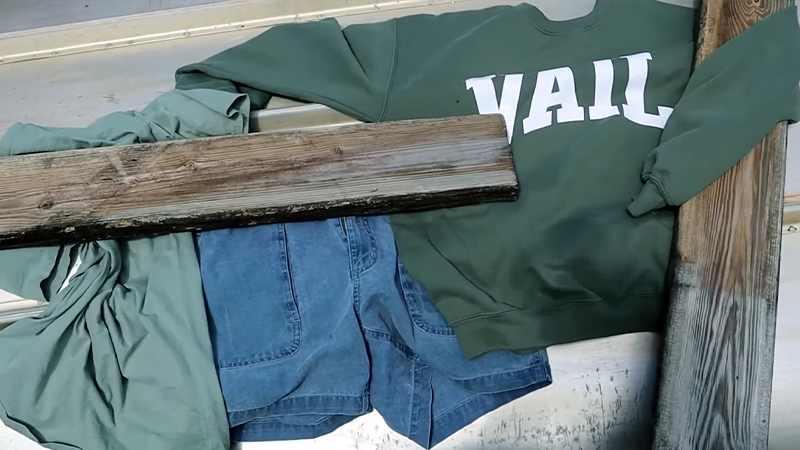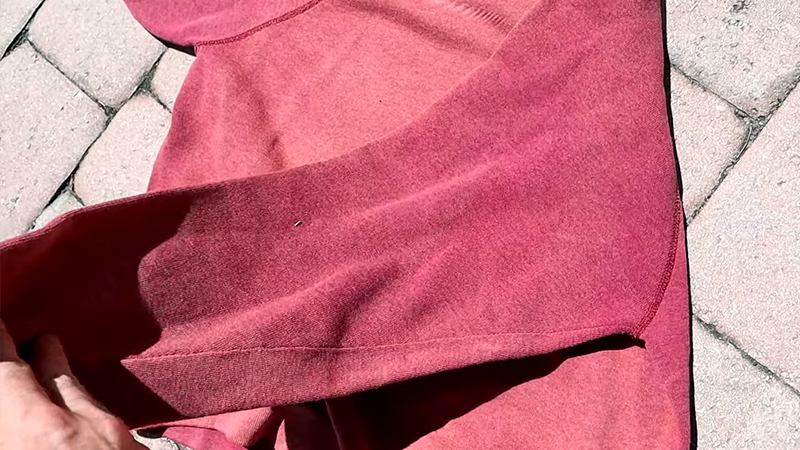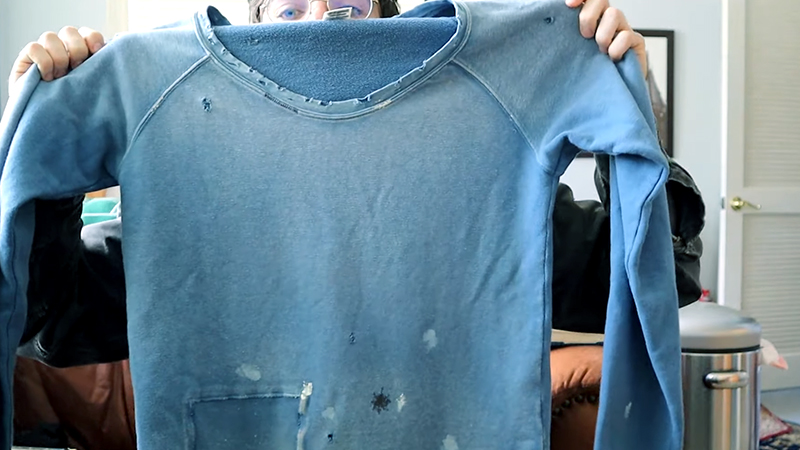The resilience and timeless elegance of wool have made it a cherished fabric for generations.
However, beneath its warmth and luxurious texture lies a vulnerability to the relentless force of the sun. This intriguing phenomenon raises the question: Does wool fade in the sun? The answer, unequivocally, is yes.
The natural fibers of wool can succumb to the effects of ultraviolet (UV) radiation, leading to a gradual loss of color intensity and vibrancy.
In this exploration, we delve into the science behind wool fading, the factors influencing it, and how to protect and restore woolen treasures that have been touched by the sun’s gentle yet unforgiving rays.

Does Wool Fade in the Sun?
Yes, wool can fade in the sun. Wool is a natural fiber that can be susceptible to fading when exposed to prolonged sunlight. This is primarily due to the interaction between ultraviolet (UV) rays from the sun and the pigments in the wool fibers.
Over time, these UV rays can break down the chemical bonds in the dye molecules, causing them to lose their color intensity.
Several factors can influence the extent to which wool fades in the sun:
Dye Type
Natural dyes, derived from plants, insects, or minerals, tend to be more susceptible to fading. These dyes often lack the chemical stabilizers found in synthetic dyes that offer UV protection.
Synthetic dyes are typically more resistant to fading as they are engineered to withstand various environmental factors, including UV exposure.
UV Radiation
Sunlight contains ultraviolet radiation, which is a form of electromagnetic energy. UV rays have a shorter wavelength and higher energy compared to visible light.
When wool is exposed to sunlight, these UV rays come into contact with the surface of the fibers.
Chemical Bonds in Dyes
Wool is often dyed with various pigments to achieve different colors. These dyes are chemical compounds that bond with the fibers to give them their color. However, these chemical bonds are not infinitely stable.
Breakdown of Chemical Bonds
When UV rays interact with the dye molecules, they can disrupt the chemical bonds that hold the dye to the wool fibers.
This process is known as photodegradation. The high energy of UV rays can cause the bonds to weaken or break, leading to a gradual loss of color intensity.
Color Fastness
Colorfastness is assessed through standardized tests that simulate real-world conditions like exposure to light, washing, and friction. Dyes with excellent color fastness will maintain their vibrancy longer under such conditions.
High-quality dyes and proper dyeing techniques contribute to better color fastness, making them more resistant to fading.
Exposure Duration
Prolonged exposure to sunlight is a key factor in the fading of wool. Over time, the cumulative effect of UV rays gradually weakens the chemical bonds in the dye molecules, leading to fading.
It’s especially important to be cautious with items like wool rugs or upholstery that may be in constant exposure to sunlight.
Intensity of Sunlight
The intensity of sunlight varies based on geographic location, time of year, and altitude.
Wool items in regions with consistently strong sunlight or at higher altitudes are more prone to accelerated fading. It’s important to consider these factors when deciding where to place or store woolen items.
Protection Measures
Storing wool items in a dark or shaded area when not in use can significantly extend their lifespan. This minimizes direct exposure to UV rays and reduces the risk of fading.
Window coverings like curtains, blinds, or UV-blocking films can be effective in limiting the amount of sunlight that reaches your wool fabrics.
Preventative Treatments
Some fabric treatments, like UV protectant sprays or finishes, can be applied to wool to enhance its resistance to fading. These products create a protective barrier that helps shield the fibers from UV damage.
It’s advisable to follow manufacturer instructions and conduct a spot test before applying any treatment to ensure compatibility with the specific wool fabric.
Signs of Wool Fading

Recognizing signs of wool fading is important for maintaining the quality and appearance of your woolen items.
Here are some common indicators of fading in wool:
Loss of Vibrancy
Faded wool often appears less lively and vibrant compared to its original color. The once-bold and rich hues may lose their intensity.
You may notice that the wool fabric lacks the depth and brilliance it once had.
Uneven Coloration
Fading can occur unevenly across the fabric. Some areas may fade more rapidly than others, resulting in a mottled or patchy appearance.
This unevenness can be especially noticeable in wool items that receive varying levels of sunlight exposure.
Shift in Hue
Fading can lead to a noticeable shift in hue. For instance, a deep red might fade into a lighter, almost pinkish shade.
These hue shifts can significantly alter the overall appearance of the wool item.
Faded Areas Around Seams or Edges
Wool items, particularly clothing, may exhibit fading around seams, edges, and other areas that are more exposed to sunlight.
The contrast between faded and non-faded sections can be particularly evident in these high-exposure regions.
Comparison to Unfaded Sections
To assess fading accurately, compare the faded portion of the wool item to an unfaded section. A hidden fold or interior lining can serve as a reference.
This side-by-side comparison can help you gauge the extent of fading and whether it’s time for restoration or protection measures.
Loss of Depth
Faded wool often lacks the depth and dimensionality of its original color. The interplay of light and shadow on the fabric may be less pronounced.
This loss of depth can make the wool item appear flat and less visually appealing.
Subtle Color Changes
In some cases, fading can be subtle and not immediately noticeable. It may manifest as a slight shift in color that becomes more apparent over time.
Regular inspection and close examination of wool items can help you detect these subtle changes.
Yellowing or Browning
Prolonged exposure to sunlight can lead to yellowing or browning of wool fibers. This is often seen in conjunction with fading.
The wool may take on a discolored, aged appearance, which is undesirable for most wool items.
Fabric Texture Unaffected
It’s important to note that while fading affects the color of wool, it typically doesn’t alter the fabric’s texture. The feel and structure of the wool remain relatively unchanged.
Light Testing
To gauge the potential for fading, conduct a light test by exposing a small, inconspicuous area of the wool to sunlight for a brief period.
Comparing this exposed area to an untouched section of the wool will give you a clear indication of how susceptible the fabric is to fading.
Restoring Faded Wool

Restoring faded wool involves revitalizing the color and vibrancy of the fabric.
While complete restoration may not always be possible, there are several approaches you can take to enhance the appearance of faded wool items:
Professional Redyeing
Engaging a professional dyer or textile specialist is one of the most effective ways to restore faded wool.
They have the expertise, tools, and resources to carefully redye the fabric, bringing back its original color or a close approximation.
Matching and Testing
Before proceeding with redyeing, it’s crucial to accurately match the color. This is typically done by providing a sample or swatch to the dyer, who can then custom mix the dye to achieve the desired shade.
Additionally, a small test patch should be done to ensure that the chosen dye adheres properly and produces the intended result.
Dyeing at Home
If you’re experienced with dyeing textiles, you may choose to attempt the process at home. Select a high-quality fabric dye and follow the manufacturer’s instructions carefully.
It’s essential to consider factors such as dye type, color fastness, and proper application techniques to achieve the best results.
Avoiding Overdyeing
Overdyeing can result in a color that’s too intense or uneven. To prevent this, start with a lighter shade and gradually build up the color, if needed, through multiple dyeing sessions.
Specialty Dyes and Treatments
Some specialty dyes are designed specifically for restoring faded fabrics. These may include color-enhancing or color-correcting products that can help revitalize the wool.
Natural Dye Methods
For those seeking a more natural approach, certain plant-based dyes can be used to restore color to wool. While this may not achieve the exact original shade, it can provide a unique, natural look.
Consulting a Professional
If you’re uncertain about the best approach for your specific wool item, consulting a professional dyer or textile conservator is recommended. They can assess the fabric’s condition and provide tailored advice on restoration options.
Protective Measures
Once the wool has been restored, it’s important to implement protective measures to prevent future fading. Store wool items in shaded areas, use UV-blocking coverings and avoid prolonged exposure to direct sunlight.
Care and Maintenance of Wool Items After Restoring

After restoring faded wool items, it’s crucial to implement proper care and maintenance practices to preserve the newly revitalized colors and extend the life of the fabric.
Here are some key steps to follow:
Gentle Washing
When handwashing, it’s important to use water that is cool to lukewarm. Additionally, choosing a detergent specifically designed for wool is crucial.
These detergents are formulated to clean effectively without compromising the integrity of the delicate wool fibers. During the washing process, gently agitate the water by moving the item back and forth.
Avoid any vigorous scrubbing, as this can lead to unnecessary friction and potential damage.
Cold Water Only
Using cold water is paramount in preventing the wool from shrinking. Hot water can cause the wool fibers to constrict and potentially felt together, resulting in irreversible damage to the fabric’s structure and appearance.
Avoid Agitation
It’s crucial to handle the wool with utmost care during the washing process. Avoid any twisting, wringing, or vigorous scrubbing, as these actions can cause distortion, stretching, or felting of the delicate fibers.
Instead, opt for a gentle, swaying motion to ensure thorough cleaning.
Rinsing and Patting Dry
After the washing process, the rinsing stage is equally important. Rinse the wool item thoroughly under cold running water until all traces of detergent are removed.
Ensuring that the water runs clear indicates that the item is properly rinsed. Following rinsing, it’s recommended to gently press the fabric between clean, dry towels to absorb excess moisture.
Be cautious and avoid any excessive squeezing or wringing, as this can lead to unnecessary stress on the fibers.
Drying Flat
Once the item is washed and excess moisture is absorbed, it should be laid flat on a clean, dry towel or a drying rack. This allows the wool to maintain its shape and structure during the drying process.
It’s important to gently reshape the item back to its original dimensions if any adjustments are needed.
Avoid hanging wool, as the weight of the water can cause stretching and distort the fabric’s shape.
Keep Away from Direct Sunlight
To preserve the vibrancy of the restored wool, it’s imperative to store it in a cool, dark place when not in use.
Prolonged exposure to direct sunlight can lead to fading over time, even after restoration. Taking this precautionary measure helps ensure the longevity of the colors.
Protect from Moths
Continuing to use natural moth deterrents like cedar or lavender sachets in storage areas is a crucial step in safeguarding against potential damage from moth larvae.
These natural deterrents help prevent infestations and protect the wool from any potential harm.
FAQs
Does all wool fade in the sun?
Yes, all types of wool can experience fading when exposed to prolonged sunlight.
Why does wool fade in the sun?
Wool fades due to the interaction between ultraviolet (UV) rays and the dye molecules in the fabric.
Can fading be prevented?
While fading can’t be entirely prevented, it can be minimized. Storing wool items in shaded areas, using UV-blocking coverings, and avoiding prolonged sun exposure can help.
Can faded wool be restored?
Yes, faded wool can be restored through processes like professional redyeing or using specialty dyes. However, complete restoration may not always be possible.
How can I maintain restored wool items?
To maintain restored wool, it’s essential to follow gentle washing techniques, avoid harsh sunlight, and periodically inspect for signs of wear or fading.
Wrap Up
The interaction between wool and sunlight unveils a delicate dance of color and light. As we’ve discovered, wool does indeed fade when exposed to the sun’s potent ultraviolet rays.
This fading process, driven by the breakdown of dye molecules, highlights the importance of safeguarding cherished woolen items from prolonged sun exposure.
By implementing thoughtful care and maintenance practices, such as gentle washing, avoiding harsh sunlight, and periodic inspections, we can prolong the lifespan and vibrancy of our treasured wool possessions.
With these measures, we ensure that the enduring allure of wool remains an integral part of our lives for generations to come, enriching our homes and wardrobes with its timeless beauty.
Leave a Reply